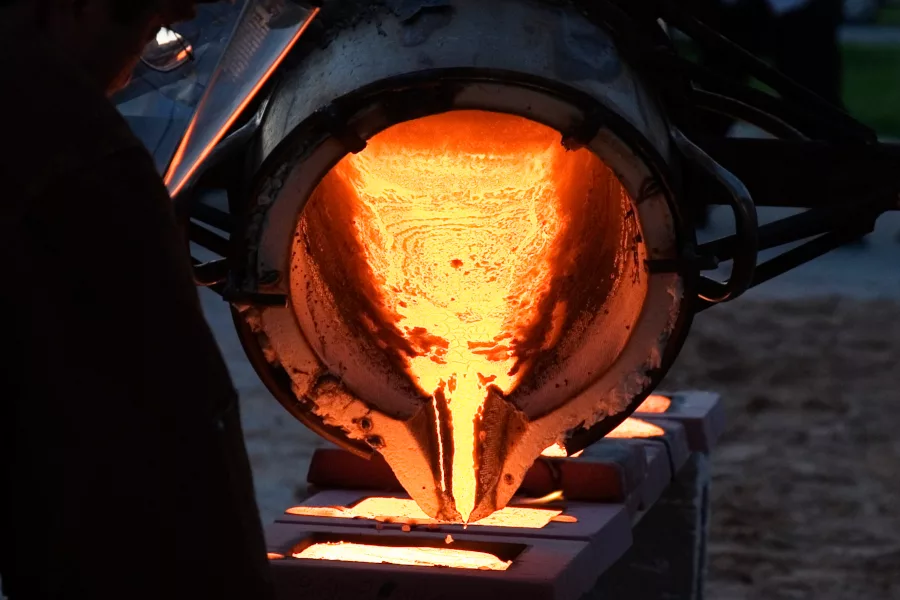Foundry Coatings Are the Foundation of a Metal Casting Business

Today’s metal casting business leaders know the importance of choosing the right foundry coatings during their operations. Here’s a closer look at these refractory coatings and how they help achieve company goals.
The foundry coating formulation consists of a high-temperature mineral or refractory material inside a liquid carrier. Since it can tolerate the characteristics of molten metal, it becomes a barrier between the hot material and a core or a metal-casting mold.
After applying refractory coatings to a surface, the liquid evaporates and leaves a layer on the sand used for metal casting. It can then improve the quality of the casting surface by resisting the penetration of the molten material into the sand.
The Components of Foundry Coatings
All refractory coatings used at foundries have ingredients that work together to give the desired results.
Refractory Minerals
The refractory mineral is the main component, and it affects how well the coating resists molten metal. It also influences how the coating impacts casting properties and which characteristics it shows during application.
Carriers
Carriers transfer the refractory mineral to the core or mold surface. Some manufacturers blend them to affect how they dry and make the coating binder more soluble. The carrier’s composition determines how deeply the coating goes into the sand, too.
Alcohol was traditionally a popular carrier choice for foundry coatings. However, water-based versions are becoming more widely used. As COVID-19 drove the demand for surface and hand cleaners containing alcohol, it became increasingly difficult to obtain the raw material at reasonable rates. Research suggests foundry operators could save up to 70% by switching to a coating with a water-based carrier.
Binders
Refractory coatings’ binders hold the particles together and make them adhere to the sand. Some common binders include acrylics and wood-based resins. A well-chosen binder helps the coating tolerate handling when dry and is flexible enough to let the sand expand after application.
Suspension Agents
Coatings also have agents that keep the refractory particles suspended and prevent them from settling during shipments or prolonged storage periods. This agent also helps a refractory coating retain its viscosity during use. The chosen agent, which is often a polymer or clay, affects the coating’s characteristics during application.
Additives
Refractory coatings often have additives that help them achieve specific desirable properties. They include defoamers and leveling agents. Besides changing how the coating behaves during application, these additional ingredients to the foundry coating formulation can enhance casting performance or prolong the product’s shelf life.
Selecting the Coating Method
There are four primary ways to apply foundry coatings to sand molds. Understanding the advantages and disadvantages of each one will increase the chances of getting the best results.
Spraying
This option can provide ample coverage in a short time frame. However, operator attentiveness affects the overall outcome. For example, someone may miss parts of the mold or have difficulty applying enough coating to areas with deep pockets. Conversely, they may use too much of the product while spraying, leading to preventable waste.
Brushing or Swabbing
These methods allow operators to achieve consistent coverage and a greater amount of precision than spraying provides. That’s particularly true when working the refractory coatings around a mold’s corner or onto its wall.
Flow Coating
Some sources suggest that 35%-50% of jobs may be automated by 2035. Flow coating is an application technique that’s easy to automate, and it works well for covering a large surface area. However, a potential downside is that the associated equipment requires ongoing upkeep.
Dipping
People can also automate this application technique, although some still do it by hand. Dipping is a time-intensive process if performed manually. However, applying automation to the task helps bring even coverage and gives good results in high-volume facilities.
Regardless of the kind of refractory coating chosen, people must plan enough time for it to dry. Some solvent coatings dry with exposure to a flame, while water-based ones need heat. The specifics vary depending on the type, and operators should always follow the manufacturer's instructions.
A Brief Look at Factors Influencing Coating Choices
Suitable refractory coatings must remain stable during use and storage to provide optimal benefits for foundry applications. Formulations containing attapulgite clay are sometimes used for foundry coatings, due in part to how its particles create a lattice structure that facilitates their dispersal and suspension.
A recent report on the global attapulgite market forecasted a 7.25% growth rate from 2021-2028. The publisher cited the paint and coatings market use as a key element in that penetration level during the studied period.
Zircon is another frequently chosen foundry coating option. Research shows that approximately 14% of all zircon is used in the foundry industry. Its particles keep their dimensional stability even at high temperatures.
The desired coating method will also affect the type used. For example, powder coatings often contain mixtures of ferrosilicon or graphite. Adding a dispersion agent and water to them allows using a spraying mechanism to coat the mold.
Toxicity, average drying time and flammability are other factors commonly examined when assessing foundry coatings. Thus, having a clear idea of a foundry’s business goals and requirements will help steer the selection process.
Refractory Coatings as Quality Control Influencers
Applying the most appropriate coating for specific metal-casting work can cause increased productivity by reducing the time needed to clean or repair molds. Refractory coatings also bring economic benefits by minimizing the amount of scrapped metal.
When deciding whether to use a coating and which type to choose, it’s necessary to calculate the average time needed to apply it and let it dry. However, if foundry operators select the appropriate kind, the refractory coating could improve quality control.
A coating can act as a sufficient safeguard against penetration defects and veining. However, that’s only true if a person adds approximately 10-12 mils or greater as a sand coating. Some refractory coatings also penetrate the sand core, adding additional protection that lowers a foundry’s overall defect rate.
Some foundry coatings also change color when dry. That visual indicator is especially useful when applying multiple layers because it prevents an operator from taking that step prematurely.
Color-change coatings can also give clues that the mixture was diluted too much during preparation. The extra moisture content would slow the overall drying time. Thus, if a foundry employee notices that it’s taking longer than usual for the coating to change hue to indicate dryness, over-dilution may be the culprit.
Are Foundry Coatings Right for Your Business?
Before committing to using refractory coatings, take the time to investigate whether the quality improvements and potential cost savings will outweigh the potential challenges associated with applying the product and allowing time for it to dry. Having accurate expectations improves the chances of being satisfied with the outcome and how the coatings affect your operations.
Looking for a reprint of this article?
From high-res PDFs to custom plaques, order your copy today!







